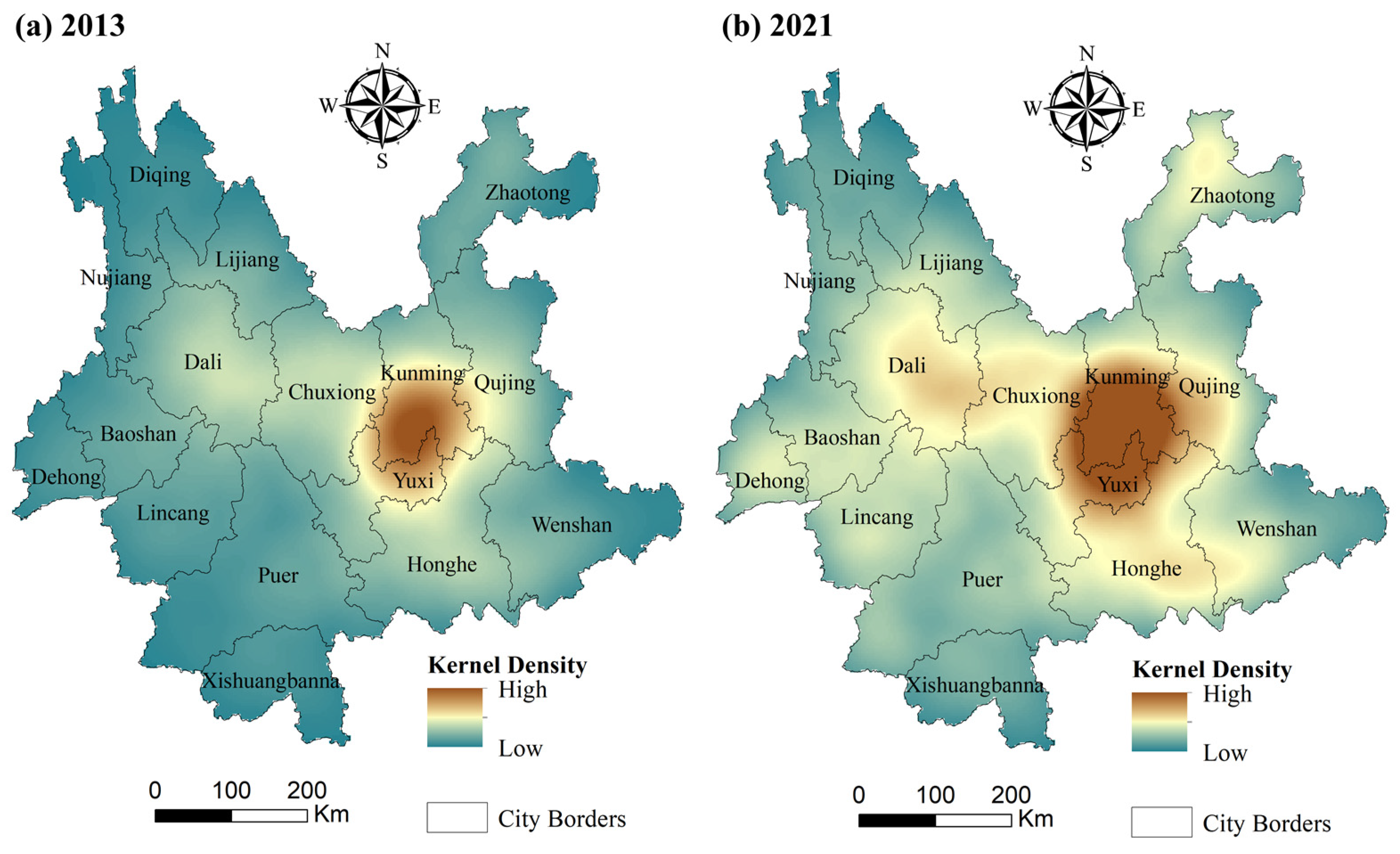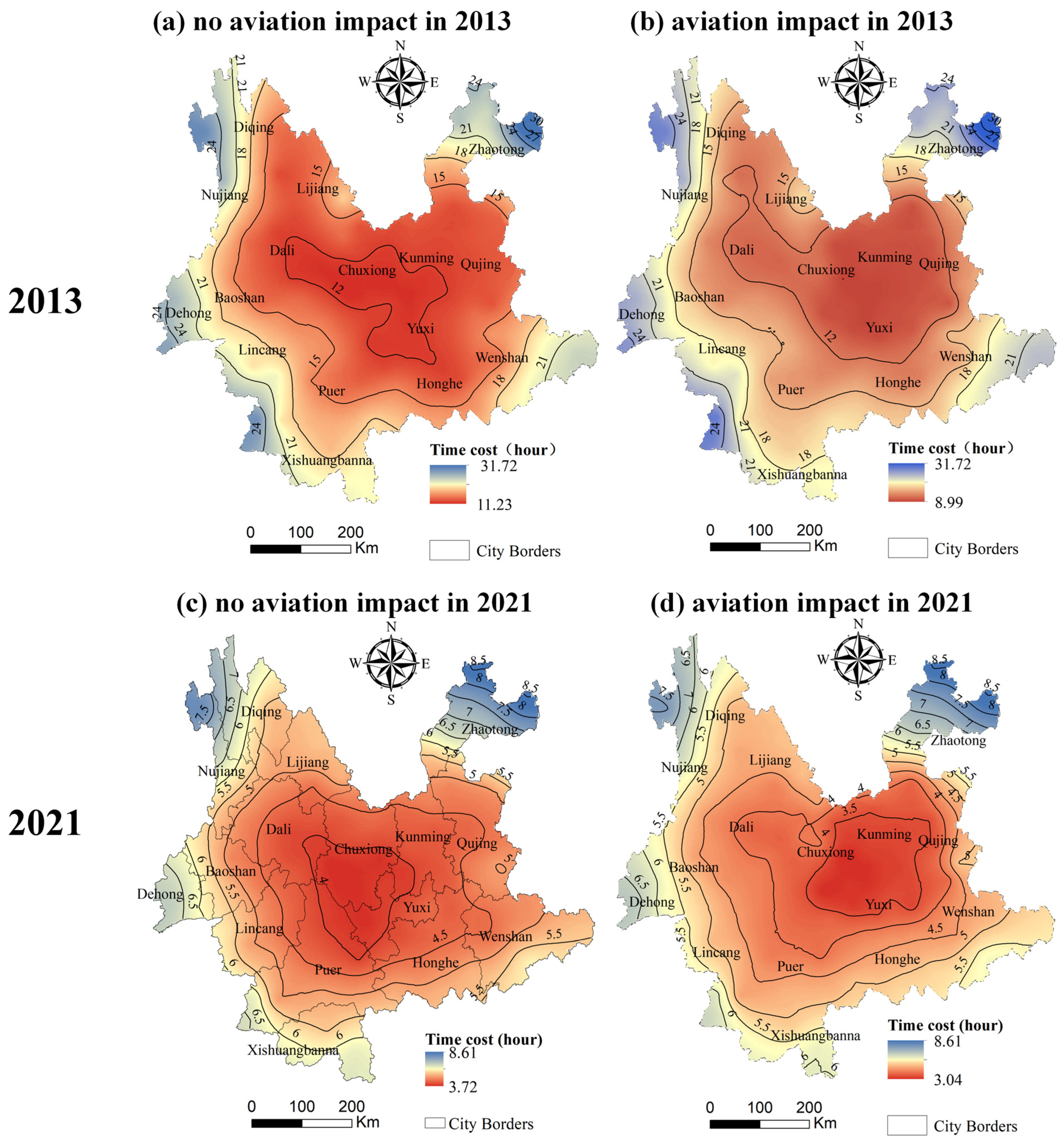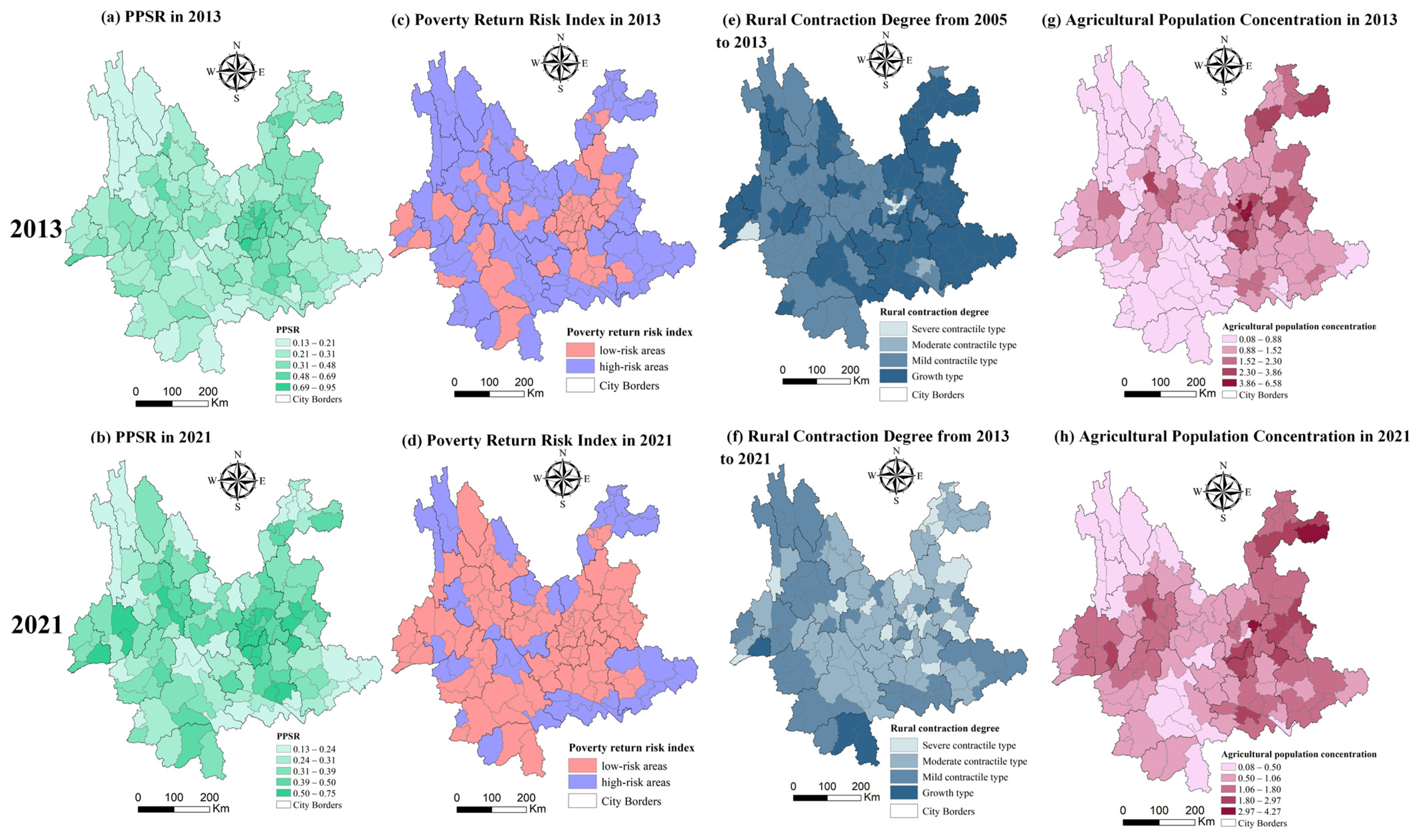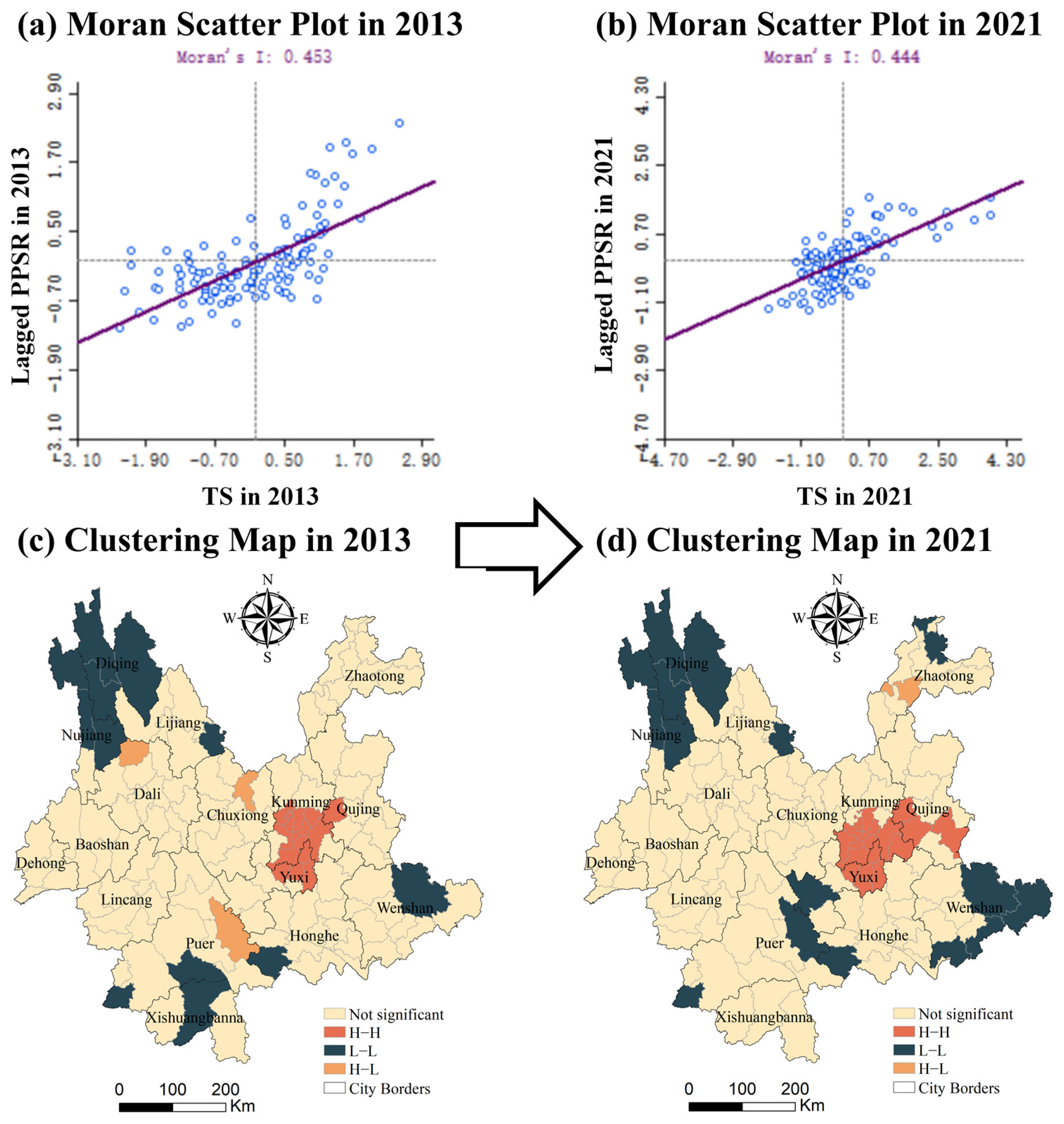Exploring the Synergy Between Transport Superiority and the Rural Population System in Yunnan Province: A Temporal and Spatial Analysis for 2013 to 2021
Abstract
1. Introduction
2. Materials and Methods
2.1. Study Area
2.2. Data Resources
2.3. Method
2.3.1. Measurement of Comprehensive Transportation Superiority
- (1)
- Measurement of “Quantity”—Weighted Road Network Density
- (2)
- Construction of a Grid Dataset for Comprehensive Transportation Cost
- (3)
- Construction of the Aviation Impact Coefficient Model
- (4)
- Measurement of “Quality”—Traffic Accessibility
- (5)
- Measurement of “Potential”—Location Advantage
2.3.2. Population Subsystem Measurement
- (1)
- Pressure—Poverty Return Risk Index
- (2)
- Status—Rural Contraction Index
- (3)
- Response—Agricultural Population Concentration
2.3.3. Data Standardization and the Entropy Method
2.3.4. Trade-Off Coordination Relationship Analysis—Spatial Autocorrelation
3. Results
3.1. Kernel Density Analysis of TS Spatiotemporal Variation
3.2. Analysis of the Aviation Enhancement Effect
3.3. Measurement Results for the Rural Population
3.3.1. Analysis of Temporal and Spatial Changes in PPSR
3.3.2. Analysis of Spatiotemporal Changes in Poverty Return Risk Index
3.3.3. Analysis of Spatiotemporal Changes in Rural Contraction Degree
3.3.4. Analysis of Spatiotemporal Changes in Agricultural Population Concentration
3.4. Trade-Off Synergy Analysis of TS and PPSR
4. Discussion
4.1. Aviation-Mediated Enhancement of Traffic Superiority in Yunnan Province
4.2. The PSR Structure of the Rural Population in Yunnan Province Shows Significant Differences
4.3. Coordinated Development Path for TS and PPSR
5. Conclusions and Limitations
- (1)
- This study proposes an aviation impact coefficient model to calculate the degree of traffic advantage in Yunnan Province. The results show that the comprehensive traffic advantage of Yunnan Province significantly improved from 2013 to 2021, forming a high-value center with Kunming, Chuxiong, and Yuxi as the core, with the surrounding areas exhibiting diminishing values. Aviation conditions have had a significant positive impact on the revitalization of rural areas in Yunnan, with provincial traffic accessibility increasing by nearly 8%. In terms of land traffic, Kunming’s regional core position has been further strengthened.
- (2)
- PPSR calculations reveal that the rural population in Yunnan Province follows a spatial pattern of “one core and multiple points”. The polarization pattern gradually weakens due to the reduction in the overall gap. Most counties in Yunnan Province have experienced varying degrees of rural contraction, exhibiting two stages of intensifying contraction. The eastern part of Yunnan is characterized primarily by a high agricultural population concentration, whereas the western region is characterized predominantly by a low agricultural population concentration. Songming and Zhenxiong have the highest agricultural population concentrations. During this period, nearly 50% of the areas at a high risk of returning to poverty were transformed into low-risk areas. However, the risk of returning to poverty remains higher in the western and border areas than in the eastern and internal regions.
- (3)
- The relationships between TS and PPSR in Yunnan Province are predominantly synergistic, with significant regional characteristics and a degree of polarization. From 2013 to 2021, TS and PPSR exhibited high-level collaborative relationships (“H-H”) with stable regional distributions, mainly in Kunming, Yuxi, and other areas. Low-level synergy (“L-L”) regions were concentrated in border areas, with the northwestern, southeastern, and southwestern regions having the majority. Therefore, districts and counties should accelerate the coordinated development of TS and PPSR, promoting mutual benefits and narrowing regional disparities.
Author Contributions
Funding
Data Availability Statement
Conflicts of Interest
References
- Liu, Y.; Li, Y. Revitalize the World’s Countryside. Nature 2017, 548, 275–277. [Google Scholar] [CrossRef] [PubMed]
- Wang, Y.; Shu, C.; Yang, L.M.; Yuan, H.Z. A Decoupling Multiple-Relaxation-Time Lattice Boltzmann Flux Solver for Non-Newtonian Power-Law Fluid Flows. J. Non-Newton. Fluid Mech. 2016, 235, 20–28. [Google Scholar] [CrossRef]
- Ficko, A.; Sarkki, S.; Gultekin, Y.S.; Egli, A.; Hiedanpää, J. Reflective Thinking Meets Artificial Intelligence: Synthesizing Sustainability Transition Knowledge in Left-behind Mountain Regions. Geogr. Sustain. 2025, 6, 100257. [Google Scholar] [CrossRef]
- Tucker, C.M.; Alcántara-Ayala, I.; Gunya, A.; Jimenez, E.; Klein, J.A.; Xu, J.; Bigler, S.L. Challenges for Governing Mountains Sustainably: Insights From a Global Survey. Mt. Res. Dev. 2021, 41, R10. [Google Scholar] [CrossRef]
- Zhang, Q.; Cao, Z.; Liu, Y. Assessing Rural Revitalization Potential through Rural Transformation Degree and Sustainability: A Quantitative Study of 460 Case Villages in Lingbao, China. Habitat Int. 2024, 153, 103194. [Google Scholar] [CrossRef]
- Tian, Y.; Jiang, G.; Ma, W.; Wu, S.; Tian, Y.; Zhou, T. Understanding the Relationship between Population–Land–Industry Element Inputs and Function Outputs of Rural Settlement: An Efficiency-Based Perspective. Habitat Int. 2025, 159, 103370. [Google Scholar] [CrossRef]
- Fromentin, J. A Spatio-Temporal Approach to Population Diversity: Immigration and Rural Areas in France. J. Rural Stud. 2023, 103, 103099. [Google Scholar] [CrossRef]
- Gu, H.; Lao, X.; Wen, Z.; Zhao, Z. Spatiotemporal Patterns and Determinants of Interprovincial Migration in China Between 2000 and 2020. Acta Geogr. Sin. 2022, 77, 3041–3054. (In Chinese) [Google Scholar] [CrossRef]
- Liu, J.; Zhou, X.; Hou, X. Does a Migrant Relocation Program Aggravate Cropland Abandonment? A Case Study on Pingli County, China. Land 2025, 14, 518. [Google Scholar] [CrossRef]
- Zhuo, R.; Xu, X.; Zhou, Y.; Guo, X. Spatiotemporal Evolution Patterns and Influencing Factors of Rural Shrinkage Under Rapid Urbanization: A Case Study of Zhejiang Province, China. Land 2024, 13, 2137. [Google Scholar] [CrossRef]
- Dzanku, F.M. Transient Rural Livelihoods and Poverty in Ghana. J. Rural Stud. 2015, 40, 102–110. [Google Scholar] [CrossRef]
- Hodgkin, S.; Mnatzaganian, G.; Warburton, J.; Winterton, R. Networks of Care in Australian Rural Ageing Populations. J. Rural Stud. 2022, 92, 17–25. [Google Scholar] [CrossRef]
- Cui, H.; Zheng, L.; Wang, Y. The Impact of Changes in Land Transfer Decisions on Rural Livelihood Transitions: Evidence from Dynamic Panel Data in China. Appl. Geogr. 2025, 176, 103515. [Google Scholar] [CrossRef]
- Huang, Y.; Elahi, E.; You, J.; Sheng, Y.; Li, J.; Meng, A. Land Use Policy Implications of Demographic Shifts: Analyzing the Impact of Aging Rural Populations on Agricultural Carbon Emissions in China. Land Use Policy 2024, 147, 107340. [Google Scholar] [CrossRef]
- Du, X.; Mohd, S. Urban–Rural Heterogeneity in the Effect of Population Ageing on the Savings Rate of Urban and Rural Households in China. Econ. Anal. Policy 2024, 82, 999–1010. [Google Scholar] [CrossRef]
- Li, L.; Zhang, T.; Yang, Y. Unveiling Nonlinear Effects of Transport Development on Rural Settlement Transitions along the “Southern Jiangsu—Northern Shaanxi” Transect in China. Ecol. Indic. 2024, 159, 111712. [Google Scholar] [CrossRef]
- Long, H.; Liu, Y.; Li, X.; Chen, Y. Building New Countryside in China: A Geographical Perspective. Land Use Policy 2010, 27, 457–470. [Google Scholar] [CrossRef]
- Liu, Y.; Li, X.; Guo, Y. Exploring Land System Reform for Demographic Transition in Rural China. Land Use Policy 2024, 147, 107355. [Google Scholar] [CrossRef]
- Yang, S.; Yang, X.; Zhang, J.; Gao, X.; Zhou, J.; Wu, X. Assessing the Impacts of Rural Depopulation and Urbanization on Vegetation Cover: Based on Land Use and Nighttime Light Data in China, 2000–2020. Ecol. Indic. 2024, 159, 111639. [Google Scholar] [CrossRef]
- Wang, F.; Li, S.; Liu, L.; Gao, F.; Feng, Y.; Chen, Z. A Novel Index for Assessing the Rural Population Hollowing at Fine Spatial Resolutions Based on Tencent Social Media Big Data: A Case Study in Guangdong Province, China. Land Use Policy 2024, 137, 107028. [Google Scholar] [CrossRef]
- Wen, Q.; Li, J.; Ding, J.; Wang, J. Evolutionary Process and Mechanism of Population Hollowing out in Rural Villages in the Farming-Pastoral Ecotone of Northern China: A Case Study of Yanchi County, Ningxia. Land Use Policy 2023, 125, 106506. [Google Scholar] [CrossRef]
- Liu, T.; Yu, L.; Chen, X.; Li, X.; Du, Z.; Yan, Y.; Peng, D.; Gong, P. Utilizing Nighttime Light Datasets to Uncover the Spatial Patterns of County-Level Relative Poverty-Returning Risk in China and Its Alleviating Factors. J. Clean. Prod. 2024, 448, 141682. [Google Scholar] [CrossRef]
- Tavosi, M.; Vafakhah, M.; Sadeghi, S.H.; Shekohideh, H.; Moosavi, V. Comparative Assessment of Watershed Hydrological Health (WHH) Using Multi-Criteria Decision-Making Approach Based on PSR Framework. J. Environ. Manag. 2025, 373, 123833. [Google Scholar] [CrossRef]
- Liu, S.; Wei, H.; He, J.; Guo, H.; Gong, X. Assessment of Urban Population Health Resilience Guided by Cardiovascular and Cerebrovascular Diseases: A Case Study of Henan Province. Environ. Impact Assess. Rev. 2023, 103, 107248. [Google Scholar] [CrossRef]
- Zhou, Y.; Wei, L.; Lan, F.; Li, X.; Bian, J. Evaluation and Optimization on Urban Regeneration Sustainability from the Perspective of Multidimensional Welfare of Resettled Resident—Evidence from Resettlement Communities in Xi’an, China. Land 2022, 11, 1258. [Google Scholar] [CrossRef]
- Hassan, A.M.; Lee, H. Toward the Sustainable Development of Urban Areas: An Overview of Global Trends in Trials and Policies. Land Use Policy 2015, 48, 199–212. [Google Scholar] [CrossRef]
- Zeng, Z.; Song, B.; Zheng, X.; Li, H. Changes of Traffic Network and Urban Transformation: A Case Study of Xi’an City, China. Land Use Policy 2019, 88, 104195. [Google Scholar] [CrossRef]
- Chen, Z.; Liu, Y.; Feng, W.; Li, Y.; Li, L. Study on Spatial Tropism Distribution of Rural Settlements in the Loess Hilly and Gully Region Based on Natural Factors and Traffic Accessibility. J. Rural Stud. 2022, 93, 441–448. [Google Scholar] [CrossRef]
- Banick, R.; Heyns, A.M.; Regmi, S. Evaluation of Rural Roads Construction Alternatives According to Seasonal Service Accessibility Improvement Using a Novel Multi-Modal Cost-Time Model: A Study in Nepal’s Remote and Mountainous Karnali Province. J. Transp. Geogr. 2021, 93, 103057. [Google Scholar] [CrossRef]
- Lu, H.; Zhao, P.; Hu, H.; Zeng, L.; Wu, K.S.; Lv, D. Transport Infrastructure and Urban-Rural Income Disparity: A Municipal-Level Analysis in China. J. Transp. Geogr. 2022, 99, 103292. [Google Scholar] [CrossRef]
- Lenaerts, B.; Allroggen, F.; Malina, R. The Economic Impact of Aviation: A Review on the Role of Market Access. J. Air Transp. Manag. 2021, 91, 102000. [Google Scholar] [CrossRef]
- Dai, Z.; Guo, R.; Li, M. Rural Transportation Facilities Improvement, Digital Countryside Development and Migrant Workers Returning Home to Start Businesses. J. China Agric. Univ. 2023, 28, 265–278. (In Chinese) [Google Scholar]
- Peng, J.; Qin, X. Research on Poverty Alleviation Effect of Agricultural Infrastructure Since the 21st Century. Chin. J. Agric. Resour. Reg. Plan. 2022, 43, 206–215. (In Chinese) [Google Scholar]
- Wang, Z.; Xu, J.; Zhu, C.; Qi, Y.; Xu, L. The County Accessibility Divisions in China and Its Correlation with Population Distribution. Acta Geogr. Sin. 2010, 65, 416–426. (In Chinese) [Google Scholar]
- Tian, Y.; Fu, C.; Jiang, L.; Dong, Y.; Li, J. Spatial Coupling and Coordination between Urban Traffic Accessibility and Regional Eeonomy in the Yangtze River Economic Belt Considering the Impact of Aviation. Geogr. Geo-Inf. Sci. 2023, 39, 84–90. (In Chinese) [Google Scholar] [CrossRef]
- Li, S.; Li, J.; Wang, H.; Yang, Z.; Liu, X.; Lei, C. Impact of Transport Superiority on Ecosystem Health in Arid Regions: A Case Study of Southern Xinjiang, China. Ecol. Indic. 2024, 162, 112054. [Google Scholar] [CrossRef]
- Minaei, M. Evolution, Density and Completeness of OpenStreetMap Road Networks in Developing Countries: The Case of Iran. Appl. Geogr. 2020, 119, 102246. [Google Scholar] [CrossRef]
- JTG D20-2017; Design Specifications for Highway Alignment. China Communications Press: Beijing, China, 2017.
- Zhu, G.; Zhou, Z.; Zhang, Y.; Zhang, H.; Zhu, Y. Spatial Differentiation Characteristics of Road Networks Density under the Background of Roads Connectivity among Villages in Guizhou Province. Highway 2021, 66, 252–256. (In Chinese) [Google Scholar]
- JTGB01-2020; Technical Standard for Highway Engineering. Ministry of Transport of China: Beijing, China, 2020.
- Wu, J.; Liu, X. The Opening of High Speed Railway and Poverty Reduction in Rural China: Evidence from Remote Sensing Data. World Econ. Pap. 2022, 1, 1–17. (In Chinese) [Google Scholar]
- Smith, B.; Wills, S. Left in the Dark? Oil and Rural Poverty. J. Assoc. Environ. Resour. Econ. 2018, 5, 865–904. [Google Scholar] [CrossRef]
- Lv, D.; Zhang, Y.; Liu, Y. Spatial Coupling Relationship Between Rural Population and Economy Under the Background of Rural Shrinkage in Songnen Plain. Econ. Geogr. 2022, 42, 160–167. [Google Scholar] [CrossRef]
- Wei, W.; Xiao, L.; Zhang, X.; Jin, L.; Wang, D.; Long, X.; Yang, Q.; Li, J.; Zhou, Y. Spatial–Temporal Analysis of Coupling Coordination Between New Urbanization and Ecological Environment in Ya’an, China. Land 2025, 14, 65. [Google Scholar] [CrossRef]
- Fageda, X.; Suárez-Alemán, A.; Serebrisky, T.; Fioravanti, R. Air Connectivity in Remote Regions: A Comprehensive Review of Existing Transport Policies Worldwide. J. Air Transp. Manag. 2018, 66, 65–75. [Google Scholar] [CrossRef]
- Gao, X.; Sun, D. Transport Accessibility and Social Demand: A Case Study of the Tibetan Plateau. PLoS ONE 2021, 16, e0257028. [Google Scholar] [CrossRef]
- Shin, S.; Kim, T.-H. Assessing Negative Externalities of Rural Abandoned Houses in South Korea: Insights from Discrete Choice Experiments. Sustainability 2024, 16, 10877. [Google Scholar] [CrossRef]
- Cheng, M.; Yin, Z.; Westlund, H. Counterurbanization in China? A Case Study of Counties in Huang-Huai-Hai Area from the Perspective of Urban-Rural Relations. J. Rural Stud. 2024, 110, 103386. [Google Scholar] [CrossRef]
- Huang, G.; Zhang, M.; Qin, B. Poor Effect Test of Natural Geographical Environment in Arid Areas. China Popul. Resour. Environ. 2014, 24, 138–146. (In Chinese) [Google Scholar]
- Sofue, Y.; Kohsaka, R. Conversion Patterns of Agricultural Lands in Plains and Mountains: An Analysis of Underpinning Factors by Temporal Comparison with Geographically Weighted Regression in Depopulating Rural Japan. Environ. Sustain. Indic. 2024, 22, 100346. [Google Scholar] [CrossRef]
- Gao, X.; Xu, A.; Liu, L.; Deng, O.; Zeng, M.; Ling, J.; Wei, Y. Understanding Rural Housing Abandonment in China’s Rapid Urbanization. Habitat. Int. 2017, 67, 13–21. [Google Scholar] [CrossRef]
- Zhang, Z.; Ding, J.; Zhang, K.; Deng, X. Impact of Aging on Farmland Abandonment: Evidence from Rural China. Land 2025, 14, 393. [Google Scholar] [CrossRef]
- Liu, Y.; Lu, S.; Chen, Y. Spatio-Temporal Change of Urban–Rural Equalized Development Patterns in China and Its Driving Factors. J. Rural Stud. 2013, 32, 320–330. [Google Scholar] [CrossRef]
- Huang, A.; Xu, Y.; Zhang, Y.; Lu, L.; Liu, C.; Sun, P.; Liu, Q. A Spatial Equilibrium Evaluation of Primary Education Services Based on Living Circle Models: A Case Study within the City of Zhangjiakou, Hebei Province, China. Land 2022, 11, 1994. [Google Scholar] [CrossRef]





| Road Type | Motorway | National Highway | Provincial Highway | County Road | Township Road | Ramp | Railway |
| Weight | 0.4 | 0.2 | 0.18 | 0.12 | 0.07 | 0.03 | 1 |
| OSM | Motorway | Trunk | Primary | Secondary | Tertiary |
| Corresponding Type | High-Speed Highway | National Highway/Urban Expressway | Provincial Road /Main Road | County Road/Secondary Trunk Road | Township Road/Branch Road |
| Speed (km/h) | 110 | 70 | 60 | 40 | 35 |
| OSM | Link | Railway | |||
| Corresponding Type | Ramp | Ordinary Railway | Nanning–Kunming High-Speed Railway | Shanghai–Kunming High-Speed Railway | |
| Speed (km/h) | 30 | 100 | 250 | 300 | |
| Evaluate Results | Types of Rural Contraction |
|---|---|
| Growth type | |
| Mild contraction type | |
| Moderate contraction type | |
| Severe contraction type |
Disclaimer/Publisher’s Note: The statements, opinions and data contained in all publications are solely those of the individual author(s) and contributor(s) and not of MDPI and/or the editor(s). MDPI and/or the editor(s) disclaim responsibility for any injury to people or property resulting from any ideas, methods, instructions or products referred to in the content. |
© 2025 by the authors. Licensee MDPI, Basel, Switzerland. This article is an open access article distributed under the terms and conditions of the Creative Commons Attribution (CC BY) license (https://creativecommons.org/licenses/by/4.0/).
Share and Cite
Hong, Q.; Zhang, Z.; Wang, R.; Zhou, S.; Dai, Y.; Hao, J.; Ai, D. Exploring the Synergy Between Transport Superiority and the Rural Population System in Yunnan Province: A Temporal and Spatial Analysis for 2013 to 2021. Land 2025, 14, 762. https://doi.org/10.3390/land14040762
Hong Q, Zhang Z, Wang R, Zhou S, Dai Y, Hao J, Ai D. Exploring the Synergy Between Transport Superiority and the Rural Population System in Yunnan Province: A Temporal and Spatial Analysis for 2013 to 2021. Land. 2025; 14(4):762. https://doi.org/10.3390/land14040762
Chicago/Turabian StyleHong, Qiuchen, Zonghan Zhang, Ruijia Wang, Shuyu Zhou, Yao Dai, Jinmin Hao, and Dong Ai. 2025. "Exploring the Synergy Between Transport Superiority and the Rural Population System in Yunnan Province: A Temporal and Spatial Analysis for 2013 to 2021" Land 14, no. 4: 762. https://doi.org/10.3390/land14040762
APA StyleHong, Q., Zhang, Z., Wang, R., Zhou, S., Dai, Y., Hao, J., & Ai, D. (2025). Exploring the Synergy Between Transport Superiority and the Rural Population System in Yunnan Province: A Temporal and Spatial Analysis for 2013 to 2021. Land, 14(4), 762. https://doi.org/10.3390/land14040762









